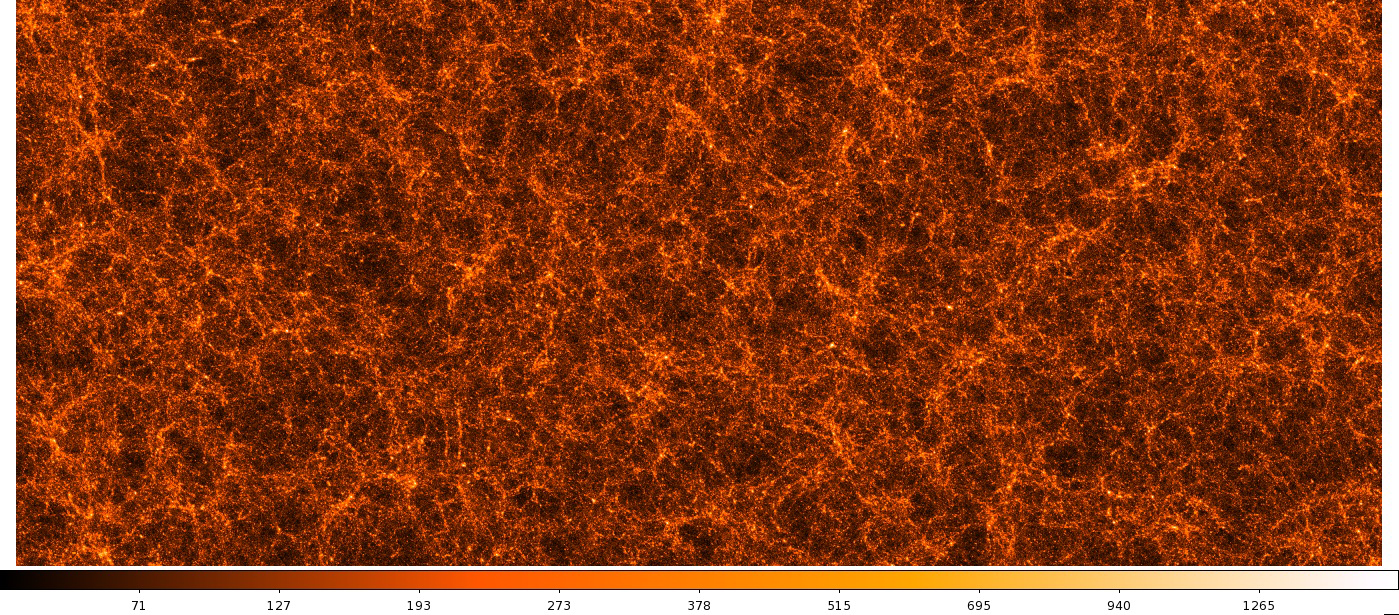Nuclear and Particle Physics, Astrophysics, and Cosmology

Simulation of the cosmic web of the dark matter mass distribution. This region represents about 1/10,000 of the total simulation volume.
Scientific and technical leadership in fundamental and applied theoretical research on on nuclear, particle, astrophysics, and cosmology theory and simulations
There is a great breadth in the research being done, including gravitation and gravitational waves, precision cosmology, dark matter and dark energy, neutrino physics, astroparticle physics, high energy astrophysics, cosmology and galaxy formation, plasma astrophysics, proto-planet formation and migration, and astrophysical data analysis and processing.- Anna Catherine Hayes-Sterbenz, Group Leader
- Chris Lee, Deputy Group Leader (acting)
- Lori Lopez, Administrator
- Ashley Mondragon, Administrator
- Tanmoy Bhattacharya
- Joseph A. Carlson
- Vincenzo Cirigliano
- Stefano Gandolfi
- Michael Lawrence Graesser
- Fan Guo
- Rajan Gupta
- Gerald M. Hale
- Michal Herman
- Gerard Jungman
- Toshihiko Kawano
- Hui Li
- Amy Lovell
- Emanuele Mereghetti
- Matthew Ryan Mumpower
- Duff Austin Neill
- Mark Paris
- Daniele Spier Moreira Alves
- Ionel Stetcu
- Ingo Tews
- Ivan Mateev Vitev
- Alessandro Baroni
- Joshua Calcino
- Adam Dempsey
- Patrick DeNiverville
- Senbei Du
- Kaori Fuyuto
- Sergi Gonzalez-Solis de la Fuente
- Weiyao Ke
- Yaping Li
- Joshua Martin
- Wendell Misch Gordon
- Bhupendra Mishra
- Samuel Novario
- James David Sadler
- Burak Sahinoglu
- Hirokazu Sasaki
- Trevor Sprouse
- Oleksandr Tomalak
- Ronen Weiss
- Bin Yan
- Qile Zhang
- Jesse Teuber Coburn
- Gavin Combs
- Filippo Delzanno
- Omar French
- Samuel Green
- Grant Johnson
- Jiaru Li
- Kelsey Alexandra Lund
- Lowell Brown
- James Lewis Friar
- Joseph Ginocchio
- Terry Goldman
- Benjamin F. Gibson
- Alice Harding
- Peter Herczeg
- Calvin Johnson
- Patrick Kilian
- Andy Liao
- Diego Lonardoni
- Richard Silbar
- Marc Verriere
- Timothy Waters
- Theory
- Modeling
- Simulation
- Nuclear Information Service
- Nuclear Physics
- Particle Physics
- Astrophysics
- Cosmology
Basic Nuclear Physics
- Nuclear Structure/Reactions (often as probes of fundamental physics)
- Nuclear Astrophysics (neutron stars, supernovae, nucleosynthesis,...)
- QCD and RHIC/LHC (quark-gluon plasma, jets and energy loss,...)
- Fundamental Symmetries and Neutrinos (ultra cold neutrons, Majorana, supernovae neutrinos,...)
Applied Nuclear Physics
- Light Nuclei (TN Burn, R-matrix, nuclear astrophysics,...)
- Heavy Nuclei
- Nuclear Masses, R-process
- Capture Reactions
- Fission
- Applications
- Nuclear Weapons
- Nuclear Energy
- Nuclear Diagnostics for NIF
- Threat Reduction
- Nuclear reactions and structure for applied and basic science
- Nuclear many-body theory
- Nuclear reaction theory
- Fission
- Nuclear data evaluation
- Processing and validation testing for applications that include
- stockpile stewardship
- threat reduction
- energy security
- heavy ion physics
- nuclear astrophysics
- physics beyond the standard model
- neutrino physics
- lattice quantum chromodynamics
- nonequilibrium field theory
- astroparticle physics
- high energy astrophysics
- proto-planet formation and migration
- astrophysical data analysis and processing
- plasma astrophysics
- cosmology and galaxy formation
- gravitation and gravitational waves
- precision cosmology
- dark matter and dark energy
The standard Fortran-77 release of the NJOY Nuclear Data Processing System. The system is used to convert evaluated nuclear data in the Evaluated Nuclear Data Format (ENDF) into forms useful for a wide range of nuclear applications. This area is only to provide user support, such as updates and sample problem outputs. To obtain an official copy of NJOY99, contact one of the code centers (RSICC, NEA-Data Bank, etc.).
NJOY 2012New version of the NJOY Nuclear Data Processing System using Fortran-90/95 style. It includes all the capabilities of NJOY 99 plus an ability to process evaluations using the newer Reich-Moore Limited (RML) resonance format now allowed in ENDF files. The NJOY 2012 User Manual LA-UR-12-27079_Rev is available here and in the Publications area. For an alternative description of NJOY 2012, see the Nuclear Data Sheets article.
TRANSX 2<Code for preparing data tables for nuclear transport codes from cross-section libraries in MATXS format. HTML instruction manual
An interactive nuclear data viewer that you can use to construct a variety of plots containing experimental data and theoretical curves. It has access to a wide variety of evaluated and processed data, and the plots can be customized to meet the user's desires.
US ENDF/B LibrariesThe US standard evaluated nuclear data libraries are denoted by ENDF/B. A number of versions have been issued over the years, the current one being ENDF/B-VII.1. This area also gives access to earlier versions. Plots are available. In addition to neutron data, charged-particle data, photo-nuclear data, thermal data, and atomic data can be found.
European JEFF LibrariesWe currently have JEFF-3.1, JEFF-3.0, and EAF2010 loaded. Users can obtain downloadable files, view interpreted versions of the evaluations, and look at plots of the processed data.
Japanese JENDL LibrariesJENDL-4 is featured, but JENDL-3.3 and JENDL-3.2 are also available. Downloadable files, interpreted files, and plots are provided. As a special feature, color PDF plots of the JENDL-4 covariances are also provided.
Chinese CENDL LibrariesWe are providing CENDL-2. Downloadable files, interpreted files, and plots are available.
Russian Nuclear Data LibrariesThe Russian BROND-2.2 cross section library and the ADL-3T activation library. Downloadable and interpreted versions are available for each material. These materials are also available through the Nuclear Data Viewer.
Reaction Q-Values and Thresholds ToolCompute reaction Q-values and thresholds using experimental and theoretical nuclear masses.
Nuclear Astrophysics DataNuclear astrophysics calculations of nucleosynthesis in stars or the Big Bang, stellar evolution, and super-nova dynamics require good nuclear cross section information and nuclear properties, such as masses and lifetimes, for a very large number of nuclides. This area is intended to give the nuclear astrophysics community easy access to such data from Los Alamos.





